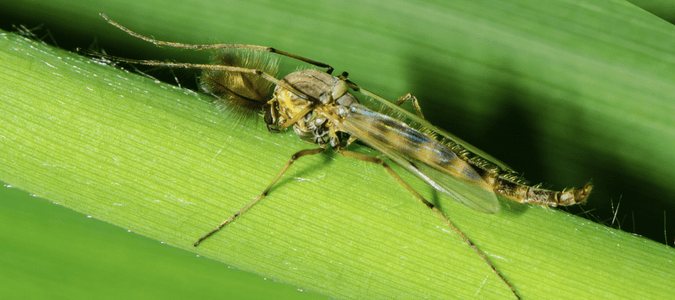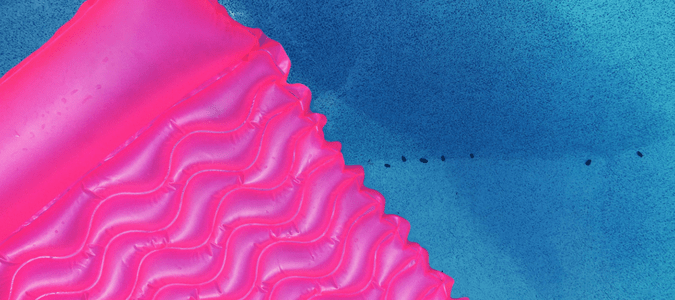Living near water is a dream for lots of people, but it can come with its own issues. Things you might even call a nuisance—or nuisance midges, to be exact. If you live near a lake or a pond, you’re likely familiar with these annoying, mosquito-like little insects. But what exactly are nuisance midges? Are they dangerous to humans? And what’s the best way to get rid of them?
Identifying Midges
Though these small flying insects look a lot like mosquitoes, they are actually a type of fly. This is why they’re also known as “blind mosquitoes” or non-biting midges. One way to tell midges apart from mosquitoes is their antennae. Male midges have bushy, feathery-looking antennae. Of course, their antennae are hard to see, since midges are so tiny.
Whatever you call them, nuisance midges don’t bite, suck blood or carry diseases. Thus, they aren’t dangerous to people or our pets in the ways that mosquitoes can be. They’re also very small, with adult midges growing only to about an eighth of an inch long. Still, they can still be a real, well, nuisance. So what’s so bad about them?
The main problem with midges stems from their sheer number. If you’ve ever gone outside and taken a deep breath of fresh air, only to inhale a mouthful of small flying insects, there’s a good chance those were nuisance midges. They breed from mid-spring through late fall. A single female laying her eggs can lead to hundreds of midges that hatch all at once.
Adult midges feed on plant nectars and juices. They usually stick to shady spots near the water during the heat of daytime. Male midges tend to swarm at dusk. They are attracted to porch lights and other lights on houses. They cluster around these lights, and they can leave unsightly stains on a building’s exterior walls. If they get inside, they can also cause stains indoors on walls, curtains and upholstery.
Unfortunately, there aren’t many highly effective ways to treat nuisance midges or their larvae. It can be helpful to spray the exterior walls and other building surfaces where adult midges congregate. People have also tried using insecticide mists and fogs near bodies of water. Both of these methods can be effective at killing the adult midges that hang out in these areas, but they won’t kill midge eggs or larvae.
Up to a thousand midge larvae can hatch from just one egg mass. With multiple females laying eggs in a single body of water, you can see how midge populations can quickly explode. Yet treating the water to kill off these eggs and larvae also hasn’t been found to work very well. Additionally, these treatments can be harmful to other, more desirable insect and animal populations that live in the same areas.
Turning off outdoor lights at dusk will help keep midges away from your home. Similarly, closing your curtains or blinds at night will help, since midges won’t be so attracted to your interior lights. If you enjoy opening windows and doors when it’s nice outside, it’s also a good idea to make sure they have well-fitting screens with no tears or gaps. This will help to keep all sorts of pests, including mosquitoes, away from your deck.
Paying attention to your fertilizer usage can also help. Fertilizer runoff from golf courses or even people’s yards can lead to higher midge populations. Making sure you are using the right type and quantity of fertilizer in your yard will help avoid creating beneficial conditions for midges to thrive.
Still, these steps alone won’t get rid of nuisance midges. The best way to get rid of them is to address the dirty, algae-filled water they thrive in. Any standing water on your property may be harboring nuisance midges along with their eggs and larvae. If the water is dirty, filled with algae and debris, it’s even more likely to attract these pests. So draining the water or cleaning it is essential to getting rid of midges.
A pest control professional can be essential in keeping midge populations low during spring, summer and fall. A pro can determine the best combination of treatments and techniques to get rid of these pests. They can also advise you on the best ways to keep midges away, including addressing landscaping issues that may be boosting midge populations.
How to Identify Midge Larvae
Midge larvae have a unique appearance, making them easy to identify. Though adult nuisance midges and mosquitoes look alike, and both insects’ larvae grow in water, midge larvae are different from mosquito larvae in several ways. The most noticeable way is their color.
Midge larvae are thin, cylinder-shaped, segmented, and slightly curved. They have a small, distinct head and a pair of legs at one end, and they grow to about a quarter-inch long. Though they might start out brown or green, these larvae turn pinkish and then red as they grow. For this reason, some people call them blood larvae.
The midges’ larval stage is the second of four life cycle stages. The first stage is their eggs, which female midges lay in jellied masses on the surface of water. The eggs hatch into larvae, often within just a few days. These larvae then sink to the bottom, where they live in mud. As they grow from larvae into pupae, which will eventually hatch into adult midges, they feed off the algae and debris found in the water and the mud.
This is why nuisance midges are more plentiful in areas with bodies of standing water that is dirty or even polluted. What may be smelly or gross to us is nutrient-dense to these insects! Midges even thrive in standing sewage runoff.
Draining standing water on your property is an essential part of getting rid of nuisance midges. If you have an outdoor pond, you might consider stocking it with a type of fish that is known to feed on midge larvae. These animals eat mosquitoes, too! But the best way to get rid of nuisance midges is to enlist the help of a licensed pest control specialist. These professionals can use a combination of treatments and techniques, customized to your home and property, to keep these pests’ populations low.
ABC Can Make Your Property Less Attractive to Pests
Dealing with nuisance midges can be, well, a nuisance! Instead of dealing with these annoying bugs, contact ABC Home & Commercial Services. We will create a comprehensive pest control plan to keep midges and other swimming pool bugs away.

